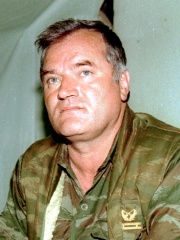
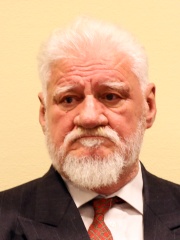
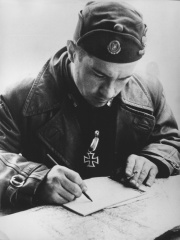
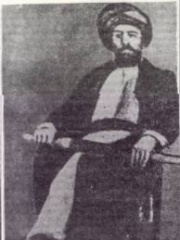


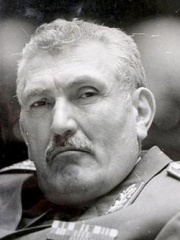

The Most Famous
MILITARY PERSONNELS from Bosnia and Herzegovina
This page contains a list of the greatest Bosnian, Herzegovinian Military Personnels. The pantheon dataset contains 2,058 Military Personnels, 11 of which were born in Bosnia and Herzegovina. This makes Bosnia and Herzegovina the birth place of the 24th most number of Military Personnels behind Romania, and Saudi Arabia.
Top 10
The following people are considered by Pantheon to be the top 10 most legendary Bosnian, Herzegovinian Military Personnels of all time. This list of famous Bosnian, Herzegovinian Military Personnels is sorted by HPI (Historical Popularity Index), a metric that aggregates information on a biography's online popularity. Visit the rankings page to view the entire list of Bosnian, Herzegovinian Military Personnels.

1. Ratko Mladić (b. 1942)
With an HPI of 79.73, Ratko Mladić is the most famous Bosnian, Herzegovinian Military Personnel. His biography has been translated into 64 different languages on wikipedia.
Ratko Mladić (Serbian Cyrillic: Ратко Младић, pronounced [râtko mlǎːdit͡ɕ]; born 12 March 1942) is a Serbian former military officer who led the Army of Republika Srpska (VRS) during the Yugoslav Wars. In 2017, he was found guilty of committing war crimes, crimes against humanity, and genocide by the International Criminal Tribunal for the former Yugoslavia (ICTY). He is serving a life sentence for these crimes in The Hague. A long-time member of the League of Communists of Yugoslavia, Mladić began his career in the Yugoslav People's Army (JNA) in 1965. He came to prominence during the Yugoslav Wars, initially as a high-ranking officer of the JNA and subsequently as the Chief of Staff of the Army of Republika Srpska in the Bosnian War of 1992–1995. In July 1996, the Trial Chamber of the ICTY, proceeding in the absence of Mladić under the ICTY's Rule 61, confirmed all counts of the original indictments, finding there were reasonable grounds to believe he had committed the alleged crimes, and issued an international arrest warrant. The Serbian and United States' governments offered €5 million for information leading to Mladić's capture and arrest, but he remained at large for nearly sixteen years, initially sheltered by Serbian and Bosnian Serb security forces and later by family. In 2011 Mladić was arrested in Lazarevo, Serbia and extradited to The Hague. His capture was considered to be one of the pre-conditions for Serbia being awarded candidate status for European Union membership. His trial formally commenced in 2012 and lasted till 2017, when he was sentenced to life in prison by the ICTY after being found guilty of ten charges: one of genocide, five of crimes against humanity and four of violations of the laws or customs of war. He was cleared of one count of genocide. As the top military officer with command responsibility, Mladić was deemed by the ICTY to be responsible for both the siege of Sarajevo and the Srebrenica massacre.

2. Slobodan Praljak (1945 - 2017)
With an HPI of 71.22, Slobodan Praljak is the 2nd most famous Bosnian, Herzegovinian Military Personnel. His biography has been translated into 43 different languages.
Slobodan Praljak (Croatian pronunciation: [slobǒdan prǎːʎak]; 2 January 1945 – 29 November 2017) was a Bosnian Croat war criminal and general found guilty by the International Criminal Tribunal for the former Yugoslavia (ICTY) of committing violations of the laws of war, crimes against humanity, and breaches of the Geneva Conventions during the 1992–1994 Croat–Bosniak War. Praljak voluntarily joined the newly formed Croatian Armed Forces after the outbreak of the Croatian War of Independence in 1991. Before and after the war he was an engineer, a television and theatre director, and a businessman. Praljak was indicted by, and voluntarily surrendered to, the ICTY in 2004. In 2013, he was convicted for war crimes against the Bosniak population during the Croat–Bosniak War alongside five other Bosnian Croat officials, and was sentenced to 20 years in jail (minus the time he had already spent in detention). Upon hearing the guilty verdict upheld in November 2017, Praljak stated that he rejected the verdict of the court, and fatally poisoned himself in the courtroom.

3. Vjekoslav Luburić (1914 - 1969)
With an HPI of 67.65, Vjekoslav Luburić is the 3rd most famous Bosnian, Herzegovinian Military Personnel. His biography has been translated into 25 different languages.
Vjekoslav Luburić (6 March 1914 – 20 April 1969) was a Croatian Ustaše official who headed the system of concentration camps in the Independent State of Croatia (NDH) during much of World War II. Luburić also personally oversaw and spearheaded the contemporaneous genocides of Serbs, Jews and Roma in the NDH. Luburić joined Ante Pavelić's Ustaše movement in 1931, left Yugoslavia the following year and relocated to Hungary. Following the Axis invasion of Yugoslavia and the establishment of the NDH with Pavelić at its head, Luburić returned to the Balkans. In late June 1941, Luburić was dispatched to the Lika region, where he oversaw a series of massacres of Serbs, which served as the casus belli for the Srb uprising. Around this time, he was appointed head of Bureau III, a department of the Ustaše Surveillance Service tasked with overseeing the NDH's sprawling network of concentration camps. The largest of these was Jasenovac, where approximately 100,000 people were killed over the course of the war. In late 1942, Luburić was appointed commander of the Croatian Home Guard's 9th Infantry Regiment but was stripped of his command after shooting and killing one of his subordinates. Under German pressure, he was placed under house arrest, but retained de facto control of the Ustaše concentration camps. In August 1944, he played a leading role in the disruption of the Lorković–Vokić plot, which sought to overthrow Pavelić and replace him with a pro-Allied government. In February 1945, Pavelić dispatched Luburić to Sarajevo, where over the next two months, he oversaw the torture and killing of hundreds of known and suspected communists. Luburić flew back to Zagreb in early April and was promoted to the rank of general. The NDH collapsed in May 1945 and its territory was reintegrated into Yugoslavia. Luburić stayed behind to conduct a guerrilla warfare campaign against the communists, during which he was seriously wounded. In 1949, he emigrated to Spain and became active in Ustaše émigré circles. In 1955, Luburić broke with Pavelić over the latter's professed support for a future division of Bosnia and Herzegovina between Greater Croatia and Greater Serbia, and formed a rival Croatian nationalist organization known as the Croatian National Resistance. The disagreement resulted in great acrimony between the two men and, when Pavelić died in 1959, Luburić was forbidden from attending his funeral. In April 1969, Luburić was found murdered in his home, a victim of either the Yugoslav secret police or rivals in the Croatian émigré community.

4. Husein Gradaščević (1802 - 1834)
With an HPI of 65.78, Husein Gradaščević is the 4th most famous Bosnian, Herzegovinian Military Personnel. His biography has been translated into 23 different languages.
Husein Gradaščević (Husein-kapetan) (31 August 1802 – 17 August 1834), also known as Zmaj od Bosne (lit. 'Dragon of Bosnia'), was an Ottoman Bosnian military commander who led an uprising against the Tanzimat, a system of political reforms with aim to modernise the Ottoman Empire. Born into a Bosnian noble family, Gradaščević became the captain of Gradačac in the early 1820s, succeeding his relatives (among whom was his father) in the position. He grew up surrounded by a political climate of turmoil in the western reaches of the Ottoman Empire. With the Russo-Turkish war (1828–29), Gradaščević's importance rose; the Bosnian governor gave him the task of mobilising an army between the Drina and Vrbas. By 1830, Gradaščević became the spokesman of all Ottoman captains in Bosnia and coordinated the defence in light of a possible Serbian invasion. Sparked by Ottoman Sultan Mahmud II's reforms that abolished the Janissaries and weakened the privileges of the nobility, and the autonomy and territory granted to the Principality of Serbia, much of the Bosnian nobility united and revolted. Gradaščević was chosen as the leader and claimed the title of Vizier. This uprising, with goals of autonomy, lasted three years and included the termination of Ottoman loyals mainly in Herzegovina. Among notable accomplishments, Gradaščević led forces victorious against the Ottoman field marshal in Kosovo. The uprising failed, and all captaincies were abolished by 1835. Temporarily exiled to Austria, he negotiated his return with the Sultan and was allowed to enter all of the Ottoman Empire except Bosnia. He died under controversial circumstances in 1834 and was most probably buried in the backyard of the Eyup Mosque in Istanbul, or nearby Eyüp Cemetery. Gradaščević received the honorific "the Dragon of Bosnia" (Zmaj od Bosne), and is considered a Bosniak national hero.
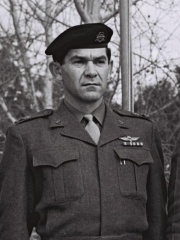
5. David Elazar (1925 - 1976)
With an HPI of 65.62, David Elazar is the 5th most famous Bosnian, Herzegovinian Military Personnel. His biography has been translated into 28 different languages.
David "Dado" Elazar (Hebrew: דוד אלעזר; 27 August 1925 – 15 April 1976) was an Israeli senior military officer who was the ninth Chief of Staff of the Israel Defense Forces (IDF), serving in that capacity from 1972 to 1974. He was forced to resign in the aftermath of the Yom Kippur War.

6. Rasim Delić (1949 - 2010)
With an HPI of 61.61, Rasim Delić is the 6th most famous Bosnian, Herzegovinian Military Personnel. His biography has been translated into 22 different languages.
Rasim Delić (4 February 1949 – 16 April 2010) was the chief of staff of the Bosnian Army. He was a career officer in the Yugoslav Army but left it during the breakup of Yugoslavia and was convicted of war crimes by the International Criminal Tribunal for the former Yugoslavia for failing to prevent and punish crimes committed by the El Mujahid unit under his command. He was sentenced to 3 years in prison.

7. Zdravko Tolimir (1948 - 2016)
With an HPI of 61.39, Zdravko Tolimir is the 7th most famous Bosnian, Herzegovinian Military Personnel. His biography has been translated into 18 different languages.
Zdravko Tolimir (Serbian Cyrillic: Здравко Толимир; 27 November 1948 – 9 February 2016) was a Bosnian Serb military commander and war criminal, convicted of genocide, conspiracy to commit genocide, extermination, murder, persecution on ethnic grounds and forced transfer. Tolimir was a commander of the Army of Republika Srpska during the Bosnian War. He was Assistant Commander of Intelligence and Security for the Bosnian Serb army and reported directly to the commander, General Ratko Mladić. He died serving a life sentence for war crimes in Scheveningen prison in 2016.

8. Blagoje Adžić (1932 - 2012)
With an HPI of 60.38, Blagoje Adžić is the 8th most famous Bosnian, Herzegovinian Military Personnel. His biography has been translated into 16 different languages.
Blagoje Adžić (Serbian Cyrillic: Благоје Аџић, pronounced [blâɡoje ǎdʒitɕ] (); 2 September 1932 – 1 March 2012) was a Serbian colonel general who served as an acting Minister of Defence of the Yugoslavia government.

9. Stanislav Galić (b. 1943)
With an HPI of 60.37, Stanislav Galić is the 9th most famous Bosnian, Herzegovinian Military Personnel. His biography has been translated into 15 different languages.
Stanislav Galić (Serbian Cyrillic: Станислав Галић; born 12 March 1943) is a Bosnian Serb soldier and former commander of the Sarajevo-Romanija Corps of the Army of Republika Srpska (VRS) during the War in Bosnia and Herzegovina. He was convicted of terror as a crime against humanity, and murder as violations of the laws and customs of war, for his part in the Siege of Sarajevo.

10. Atif Dudaković (b. 1954)
With an HPI of 58.94, Atif Dudaković is the 10th most famous Bosnian, Herzegovinian Military Personnel. His biography has been translated into 16 different languages.
Atif Dudaković (born 2 December 1953) is a retired Bosniak general who served in the Army of Republic of Bosnia and Herzegovina. During the Bosnian War, Dudaković was in command of the Bihać enclave, which was surrounded and besieged from 1992 to 1995, commanding the 5th Corps. After the war he became the general commander of the Army of the Federation of Bosnia and Herzegovina. In 2018, he was charged with war crimes.
People
Pantheon has 11 people classified as Bosnian, Herzegovinian military personnels born between 1802 and 1967. Of these 11, 4 (36.36%) of them are still alive today. The most famous living Bosnian, Herzegovinian military personnels include Ratko Mladić, Stanislav Galić, and Atif Dudaković. The most famous deceased Bosnian, Herzegovinian military personnels include Slobodan Praljak, Vjekoslav Luburić, and Husein Gradaščević.
Living Bosnian, Herzegovinian Military Personnels
Go to all RankingsRatko Mladić
1942 - Present
HPI: 79.73
Stanislav Galić
1943 - Present
HPI: 60.37
Atif Dudaković
1954 - Present
HPI: 58.94
Naser Orić
1967 - Present
HPI: 58.83
Deceased Bosnian, Herzegovinian Military Personnels
Go to all RankingsSlobodan Praljak
1945 - 2017
HPI: 71.22
Vjekoslav Luburić
1914 - 1969
HPI: 67.65
Husein Gradaščević
1802 - 1834
HPI: 65.78
David Elazar
1925 - 1976
HPI: 65.62
Rasim Delić
1949 - 2010
HPI: 61.61
Zdravko Tolimir
1948 - 2016
HPI: 61.39
Blagoje Adžić
1932 - 2012
HPI: 60.38
Overlapping Lives
Which Military Personnels were alive at the same time? This visualization shows the lifespans of the 7 most globally memorable Military Personnels since 1700.


